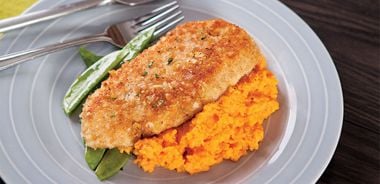Crispy Macadamia and Banana Crusted Halibut

The rich, tropical taste of macadamia nuts adds more than deliciousness to this fish dish. Macadamia nuts are a great source of heart-healthy monounsaturated fats, making this dinnertime concoction one ticker-friendly meal.
1/4 cup (60 mL) organic bread crumbs (choose coconut flour for wheat-free option)
3 Tbsp (45 mL) finely crushed macadamia nuts
3 heaping Tbsp (45 mL) finely crushed banana chips
1/4 cup (60 mL) coconut milk
1 1/2 Tbsp (22 mL) low-sodium soy sauce
4 - 5 oz (150 g) wild halibut fillets
2 tsp (10 mL) extra-virgin olive oil or coconut oil
Crush bread crumbs, nuts, and banana chips with rolling pin, or grind in processor. Place mix onto small plate and stir well to incorporate all ingredients.
In another small bowl, combine coconut milk and soy sauce. Dip each halibut fillet into milk and soy sauce mixture, letting excess liquid drip from each fillet before dipping it into bread crumb mix.
Place fish on large plate while heating oil in frying pan. When oil is sufficiently hot (but not smoking), add fish fillets and cook on both sides until golden and crispy and fish is no longer opaque, about 5 minutes on each side.
Serve with yam fries and veggies of choice for a complete meal.
Makes 4 servings.
Each serving contains: 318 calories; 31 g protein; 17 g total fat (6 g sat. fat, 0 g trans fat); 11 g total carbohydrates (3 g sugars, 1 g fibre); 328 mg sodium
source: "Go Bananas", alive #376, February 2014




